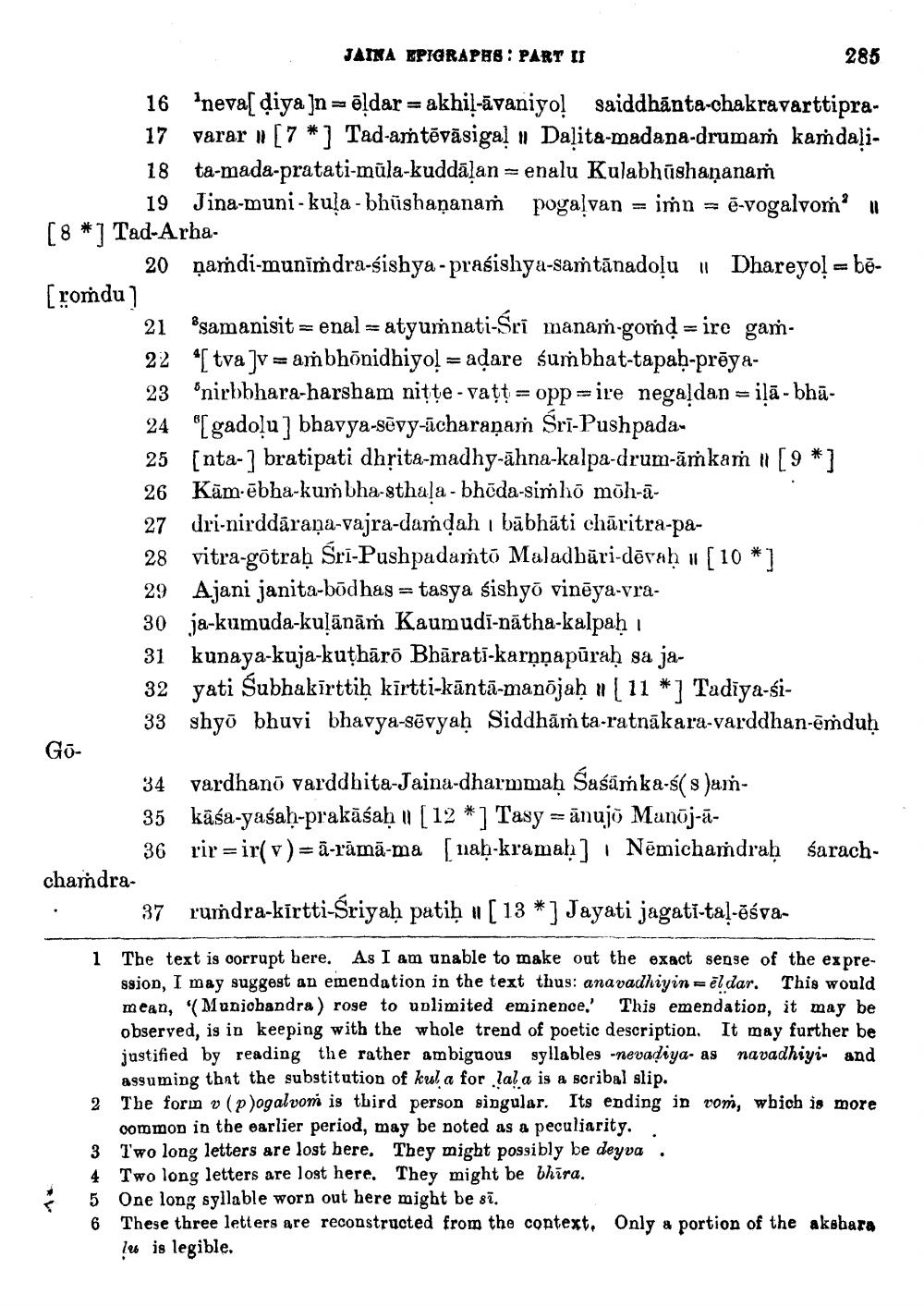________________
Gō
[8] Tad-Arha
[romdu]
chamdra
JAINA EPIGRAPHS: PART II
2
16 'neva[ ḍiya ]n=ēldar akhil-avaniyo! saiddhanta-chakravarttipra17 varar [7] Tad-amtēvasigal Dalita-madana-drumam kamdali18 ta-mada-pratati-mūla-kuddāļan = enalu Kulabhushaṇanaṁ 19 Jina-muni-kula-bhushananam
pogalvanimn ē-vogalvom2
20 namdi-munimdra-sishya - prasishya-samtanadolu | Dhareyol = be
21
*samanisit = enal = atyumnati-Śrī manam-gomḍire gam22 [tva ]v=ambhōnidhiyolaḍare śumbhat-tapaḥ-prēya23 'nirbbhara-harsham nitte-vatt opp ire negaldan = ilā - bhā24 [gadolu] bhavya-sevy-acharaṇam Śrī-Pushpada
25 [nta-] bratipati dhṛita-madhy-ahna-kalpa-drum-āmkaṁ [9 *] 26 Kām-ebha-kumbha-sthala - bheda-simhō mōh-ā
27 dri-nirddaraṇa-vajra-damḍah | bābhāti charitra-pa28 vitra-gōtraḥ Śrī-Pushpadamtō Maladhāri-dēvaḥ | [10 *]
285
29 Ajani janita-bōdhas = tasya śishyō vinēya-vra
30 ja-kumuda-kuļānāṁ Kaumudi-nātha-kalpaḥ |
31 kunaya-kuja-kuṭhārō Bhārati-karṇṇapūraḥ sa ja
32 yati Subhakirttiḥ kīrtti-kāntā-manojaḥ [ 11 ] Tadiya-si
33 shyō bhuvi bhavya-sevyah Siddham ta-ratnākara-varddhan-ēmduḥ
34
vardhanō varddhita-Jaina-dharmmaḥ Śaśāmka-ś(s)am
35 kāśa-yaśaḥ-prakāśaḥ | [12 *] Tasy = ānujō Manōj-ā
36 rir=ir(v) = ā-rāmā-ma [naḥ-kramaḥ] Nemichamdraḥ śarach
37 rumdra-kirtti-Sriyaḥ patiḥ [13] Jayati jagati-tal-eśva
#1
1 The text is corrupt here. As I am unable to make out the exact sense of the expression, I may suggest an emendation in the text thus: anavadhiyin eldar. This would mean, (Munichandra) rose to unlimited eminence.' This emendation, it may be observed, is in keeping with the whole trend of poetic description. It may further be justified by reading the rather ambiguous syllables -nevadiya- as navadhiyi- and assuming that the substitution of kula for lala is a scribal slip.
The form v (p)ogalvom is third person singular. Its ending in vom, which is more common in the earlier period, may be noted as a peculiarity.
3 Two long letters are lost here.
They might possibly be deyva
They might be bhira.
4 Two long letters are lost here. 5 One long syllable worn out here
might be sĩ.
6 These three letters are reconstructed from the context. Only a portion of the akshara 16 is legible.




